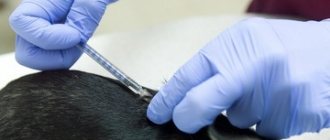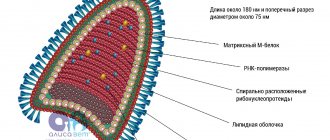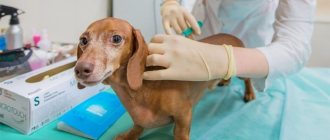Rabies is an infectious disease of a viral nature. There is currently no effective treatment against this disease. The only measure to prevent infection is vaccination.
A timely vaccination against rabies for a dog can save its life, since in accordance with the requirements of the veterinary legislation of the Russian Federation, an infected animal must be destroyed.
In this article we will tell you how often to vaccinate your dog against rabies, its validity period, when re-vaccination is necessary, and what side effects the procedure may have.
What is rabies?
Rabies is an acute infectious disease of the nervous system that causes irreversible changes and is fatal in 100% of cases. All warm-blooded animals, including dogs, are susceptible to the virus caused by rabies.
Rabies is dangerous due to its long incubation period. The virus that causes the disease moves rather slowly through nerve cells. It can take weeks for it to reach the brain or spinal cord, and until then no signs of rabies will be noticeable.
Disinfection and quarantine
After contacting a medical institution, the public service will definitely disinfect the premises where the infected animal was possibly present.
After biting a person, the dog or cat will most likely be taken to a special veterinary facility for quarantine. If the animal dies during this period, doctors will necessarily take biomaterial to accurately confirm the diagnosis.
State budgetary institution Moscow Station for the Control of Animal Diseases (State Budgetary Institution “Mosvetstation”, Moscow, Yunnatov St., 16A) is the only veterinary institution in a huge metropolis where, in accordance with veterinary legislation, inpatient quarantine of animals that have been bitten is carried out people or animals, as well as those suspected of having a disease or being infected with rabies.
What causes rabies?
The cause of the disease is the rabies virus. In 99% of cases it is transmitted through saliva during a bite. For a dog to get rabies, it must be bitten by an already infected animal . And it doesn’t have to be a dog either. The virus is transmitted by the bite of any other animal carrier (rats, mice, foxes, raccoons, etc.).
A special risk group includes stray and hunting dogs. This is due to the fact that they are more likely to come into contact with animals that may be infected with rabies.
Can the rabies virus be detected by blood and urine tests?
Unfortunately, with rabies, a general blood test can only show the presence of inflammation, as with any other viral infection - this is an increase in the number of lymphocytes, monocytes, and eosinophils may completely disappear.
A general clinical urine test will also not be able to determine a specific viral disease. There will only be an increased number of bacteria, and sometimes leukocytes (which often indicates the addition of pyelonephritis).
Theoretically, the rabies virus can be detected by PCR testing of blood, saliva or urine (Polymerase Chain Reaction). However, to carry out such an analysis you need specific laboratory equipment, which is not available in every medical center. Also, PCR can be carried out only at the very height of the disease, which is no longer advisable, because the specific symptoms of rabies will already indicate the development of a fatal disease, and the outcome will still be inevitable.
Taking blood for the presence of antibodies to the rabies pathogen is also considered an inappropriate diagnosis due to the rapid development of the disease. After all, the test results will no longer be able to influence the course of the disease and the disastrous outcome.
Standard laboratory tests cannot detect the presence of rabies virus in a patient's body fluids
How then can an accurate diagnosis be made?
At the very beginning of the 20th century, the Romanian biologist Victor Babes and the Italian pathologist Adelki Negri, using a special staining method, discovered pathomorphological formations characteristic only of this disease in the hippocampus of the brains of rabies patients, which were later called “Babes-Negri bodies.”
It is inside these bodies that the main genetic processes (transcription and replication) of the development of the rabies virus occur. Therefore, only these structures are 100% typical histological evidence of the existence of this fatal disease. Hence the conclusion:
Accurate diagnosis of rabies is only possible posthumously by taking biological material exclusively from the brain of a sick person or animal
This is the only way to make a diagnosis, which will be taken into account in the final documents.
Diagnosis of rabies - detection of Babes-Negri bodies in brain neurons
Taking biomaterial from the brain of a still living person or animal is a completely unjustified examination. The procedure is very complicated, since you need to get not to the cerebral cortex, but to the brain stem (it is deeper). There is no point in torturing the patient and provoking death from a difficult examination.
Since it is impossible to detect rabies in a still living patient using standard tests, doctors make a preliminary diagnosis based only on the fleeting manifestation of symptoms and an obvious specific picture of the disease
Diagnosis of rabies. Rabies vaccination.
How the disease manifests itself in dogs - the main signs
The first thing you need to pay attention to is changes in your pet's behavior. At first the dog begins to be afraid of water and light. She can fawn over people, including strangers, and ask for attention.
A few days later, the situation changes dramatically - the animal behaves very aggressively, breaks loose from its leash, rushes for no reason, and can bite (and this is a very dangerous period for humans, because they can also become infected!).
A dog with rabies can run a very long distance. She attacks other animals and people. At the same time, attacks of aggression and violent behavior are replaced by periods of complete rest.
The main signs indicating the development of rabies in a dog:
- lack of a swallowing reflex - saliva flows from the animal’s mouth (possibly in the form of foam),
- hard breath,
- loss of appetite,
- swallowing inedible objects,
- bouts of vomiting,
- hoarse barking,
- unsteady gait
- paralysis of the lower jaw and larynx - the animal cannot lap up water,
- paralysis of the hind limbs.
Post-vaccination period
Over the next 3 days, the dog may experience the following symptoms: refusal of usual food, lethargy, drowsiness, swelling at the injection site, allergies. As a rule, symptoms go away on their own, without medical intervention. You should not disturb your pet or force it to move, you should provide it with fresh water, and make the environment around it calm and comfortable.
After the injection, the dog is quarantined to prevent contact with an infected animal before immunity has developed. This is especially true for primary vaccinated young individuals. Puppies are restricted from walking for a month (two weeks before vaccination, two after); when immunized against rabies, the quarantine after the injection is maintained for three weeks.
Forms of rabies in dogs
Veterinary medicine distinguishes three main forms on which the clinical picture of the disease depends:
- Violent.
- Quiet (paralytic).
- Atypical.
Violent
On average, it lasts from 5 to 14 days and is divided into three stages, during which changes in the behavior of the animal are clearly expressed.
Stage 1 . The animal may exhibit atypical behavior that was previously unusual for this individual, for example, increased affection or passive aggression. Some apathy or anxiety appears. Appetite is reduced or distorted (the animal swallows inedible objects). The act of swallowing becomes difficult, vomiting, drooling and hallucinations appear.
Stage 2 . The animal shows pronounced aggression, anxiety increases greatly, there may be self-traumatization (biting its own body), the desire to run and gnaw on surrounding objects. At this stage, convulsive seizures also appear, which become more frequent and lengthen over time. Paresis of the tongue and larynx, initial paralysis of the facial muscles appear, due to which the voice becomes hoarse, muffled or disappears altogether (aphonia), the act of swallowing is disrupted, squint develops, the lower jaw droops, the tongue falls out of the mouth, and profuse and uncontrollable salivation appears. Taking food and water becomes impossible.
Stage 3, terminal - paralytic . The animal is usually severely emaciated. The gait becomes unsteady, then paralysis of the hind limbs, atony of the intestines and bladder develops. This is followed by tetraplegia (paralysis of all limbs), the animal falls into a soporous state and coma. Death occurs from respiratory arrest due to paralysis of the respiratory muscles.
Important! This is the most common form of rabies not only in dogs, but also in other animals.
Silent (paralytic)
On average, it lasts 2-4 days. Characterized by the development of paralysis, drooling, and inability to eat. There are no sudden changes in behavior, including no aggressiveness.
Atypical
The most difficult form to diagnose can last up to 3 months. There are no typical symptoms of the disease. Initially, it may manifest itself as diarrhea or, conversely, intestinal atony and depression of consciousness. During the course of the disease, temporary improvements may occur, but in the end the animal still dies with rapidly increasing neurological symptoms.
Important! Furious rabies is the most common form of rabies not only in dogs, but also in other animals.
Along with these forms, there are others. They are not so common and in the entire history of studying the disease they have been encountered only in isolated cases. These forms include:
- Returnable (remittive).
It is characterized by the fact that the signs of rabies in a dog go away, but return again. It seems that the pet has recovered, but this is not the case - and after a few days its condition worsens again. Typically, with the recurrent form, 2-3 such alternations are observed.
- Abortive.
The main feature of this form is that after the first stage the disease suddenly stops and the dog makes a full recovery. This behavior of the organism is practically not studied. The abortive form occurs in only 1-2% of infected pets.
When is the best time to vaccinate a child?
Pets can be vaccinated from the age of two months, before which they receive immune cells from their mother’s milk. In general, usually responsible owners and breeders take their children to undergo the necessary manipulations at the age of three, three and a half months.
At the first administration, vaccination is carried out twice with an interval of three to four weeks. Immunity develops within three weeks, so it is important to get vaccinated in advance before traveling.
What does rabies lead to?
Rabies is always fatal. The exception is the abortive form of the disease, but it is extremely rare. The fact is that rabies cannot be cured. Until now, no remedy has been developed that could stop the devastating consequences of the disease. If we consider that a dog can infect other animals and people with rabies, the situation becomes even more dangerous.
The only way to prevent the development of rabies is to vaccinate your dog on time.
What is required for vaccination
Having decided on the vaccines for the dog and the schedule for their administration, you will need to properly purchase the drug and buy the materials that accompany the successful administration of the injection. The vaccine is purchased at a veterinary pharmacy; it is advisable to check the permitting documentation confirming the company’s activities.
It should be understood that vaccines are stored at a temperature of 2 - 8 degrees, so to transport it home you will need a mini-fridge or thermos with ice. Be sure to study the expiration date of the injection, check the bottle for integrity (there should be no chips or visible scratches), and check whether the storage conditions are met.
They purchase related medications: 70% alcohol for disinfection or alcohol wipes, two-ml disposable syringes, a thermometer, baby cream, a veterinary passport or a notebook for recording data on the vaccination.
Why do you need a rabies vaccination?
Rabies is dangerous not only for dogs, but also for humans. Unfortunately, a sick animal is completely uncontrollable. This is no longer your affectionate and devoted dog, but only an aggressive dog that has lost its instinct of self-preservation. Neither attempts to stop her nor physical influence will help.
Vaccinating your dog against rabies is mandatory. Information that the animal is vaccinated and safe for others may be required when transporting or crossing the border, as well as in the event of an attack on another animal or person.
What vaccinations are given to puppies up to one year old?
In the first year of life, the dog receives 5 mandatory vaccinations, followed by revaccination within strictly defined periods. At the request of the owner and the recommendation of the doctor, additional vaccinations against certain infections at risk for a particular animal can be given.
Vaccination schedule for puppies
The most dangerous diseases for dogs are rabies, distemper, parovirus enteritis, leptospirosis, enteritis, parainfluenza and viral hepatitis. Most of these diseases are difficult to tolerate and can lead to the death of the animal. Some infections are also dangerous for humans. For example, rabies and leptospirosis, which affects the liver, kidneys and stomach.
Timing of vaccination for dogs in the first year of life
From distemper, leptospirosis, viral hepatitis, enteritis and parainfluenza Primary vaccination - 8-10 weeks Revaccination - 11-13 weeks Repeated vaccination - 6-7 months. and at 12 months.
Rabies Primary vaccination – 11-13 weeks
Additionally, the dog can be vaccinated against trichophytosis and microsporia. The recommended age for the planned procedure is 2-6 months of life, the second vaccination after 2 weeks. Revaccination – every year with an interval of 12 months.
When should a dog be vaccinated?
The first rabies vaccination is given to a puppy at 3-4 months. This must be indicated in the veterinary passport. Further vaccination is carried out every year - this is necessary to ensure the dog’s protection from the virus that causes rabies.
On a note! Carefully track the date of vaccination on your passport - do not violate the schedule and do not neglect vaccinations. First of all, this is caring for the health of the dog and the people around it.
Does my pet need to be vaccinated?
Even if the dog does not go outside and always stays at home, it needs to be vaccinated against rabies. And there are at least several reasons for this. Firstly, a person on the sole of a shoe or on outer clothing can bring the pathogen home. Secondly, unvaccinated animals are constantly at risk (they can become infected by accidentally running out into the street or on the way to the veterinary clinic). And thirdly, vaccination is necessary to avoid problems in case of possible trips or if your pet bites you or your guests.
First vaccination
During vaccination, a small amount of the causative agent of the virus is injected into the body. If the puppy is too small and weak, side effects may occur. Therefore, vaccination is not recommended for puppies under three months of age.
It is better to carry out the first vaccination at home, in a familiar environment for the baby.
For modern drugs, changing teeth is not considered a contraindication to injection, but try to get the injection before baby teeth begin to fall out or after they are completely replaced by permanent ones.
Puppies are re-vaccinated against rabies every year. It is important to record all vaccinations in the animal’s veterinary passport: enter the date, name and dosage of the drug.
The first anti-rabies injection is given separately, subsequent ones can be part of complex vaccines.
How to prepare for a rabies vaccination?
For vaccination to be successful, the dog must be properly prepared. The first step is to get rid of possible parasites and carry out deworming - 10-14 days before the procedure, give your pet a dewormer and carry out preventive treatment for fleas. This is necessary to restore the dog’s immunity and prevent complications after vaccination.
Recommendations for preparing your dog for rabies vaccination:
- A prerequisite for vaccination is the pet’s excellent health. If you suspect that the dog is sick (for example, it has no appetite or is acting apathetic), then it is better to postpone the procedure until the animal’s condition is completely restored.
- Ensure quarantine . Before the first vaccination, it is advisable to ensure that the dog does not come into contact with other animals. Don't forget about the special risk group that includes stray animals. Keep your pet in a clean room where you will not enter with outdoor shoes or outerwear.
- Monitor the dog's condition . Monitor your body temperature and do not introduce new foods into your diet. Give your pet more water. If you are concerned that your pet will be allergic to the vaccine, consult your veterinarian. If necessary, he will prescribe antihistamines.
Dog vaccinations: pros and cons
Vaccination of pets is carried out with the consent of the owner, so only he can decide whether to vaccinate the pet or not. According to veterinarians, it is unacceptable to refuse such a procedure. The risk of infection in unvaccinated animals is very high. Not only other dogs or rodents can be carriers of infection. Some diseases are transmitted by airborne droplets, entering the house along with dust particles, food, etc. By refusing vaccination, you are exposing the life and health of your dog to enormous risks. The diseases for which vaccinations are given cause serious complications, which can result in the painful death of the animal. To avoid dangerous consequences, you need to listen to the opinion of doctors and vaccinate your dog according to age.
Disadvantages of vaccination are possible complications that arise after the injection. The dog's body temperature may rise, loss of appetite, general condition worsen, vomiting and loose stools. If side effects are detected, the animal must be urgently shown to a specialist. The veterinarian will select treatment to eliminate adverse symptoms.
Complications of vaccination occur infrequently and are mainly due to improper preparation of the animal for the planned procedure or when using a low-quality vaccine. The doctor must examine the dog before giving the vaccination. To ensure everything goes smoothly, choose trusted veterinary clinics with a good reputation and qualified staff.
Should an old dog have vaccinations?
There is an opinion that after 8 years of age a dog does not need to be vaccinated. In fact, none of the instructions for the vaccine contain any restrictions related to the age of the animal. The only condition is that the animal must be clinically healthy. Therefore, the veterinarian has the right to postpone or cancel vaccination, taking into account the clinical condition of the animal, but not on the basis of great age. Without annual vaccination, your dog becomes vulnerable to infections, so the possible harm from vaccination is more than offset by the benefits of vaccination.
Everything you need for a happy and comfortable life for your four-legged friend can be purchased on our online store website. The catalog contains a huge selection of products for dogs - high-quality food, vitamin and mineral complexes, care accessories, cozy beds, toys, collars, parasitic and anthelmintic treatments and much more. Orders are accepted online. Sending goods to all regions of the Russian Federation.
How and where is the injection given?
The rabies vaccine is usually given subcutaneously (at the withers), but some drugs can be administered intramuscularly. Before vaccinating your dog, your veterinarian will perform an examination. Only disposable syringes are used for the procedure. After the session, a mark is placed in the veterinary passport. It indicates the date of vaccination and the drug used.
On a note! Vaccinate your dog only in a reliable veterinary clinic in Moscow. Avoid dubious offers and trust only professionals.
Contraindications to rabies vaccination
It is strictly forbidden to vaccinate a dog that is sick or has not undergone deworming. If your pet has chronic diseases, be sure to undergo a preventive examination before the procedure and take tests (if necessary, prescribed by a veterinarian).
Contraindications:
- age up to 3 months;
- pregnancy (a pregnant bitch can only be given a vaccine against rabies called “Rabizin” - it is believed that it does not affect the development of pregnancy and the fetus);
- weakened body;
- rehabilitation period (for example, after an injury);
- underweight.
After vaccination
After vaccination, the dog remains in the clinic under observation for about 20-30 minutes. Then she must be taken home and ensure complete rest. Don't forget that walking (especially in public places!) is highly undesirable. The pet needs peace and time so that it can fully relax. At the same time, the vaccinated dog must be provided with free access to food and water.
The recovery period after vaccination lasts 10-14 days. During this time it is undesirable:
- excessive water procedures;
- intense loads;
- hypothermia or overheating of the pet;
- communication with other animals.
Possible reactions
Carefully monitor your pet's condition for 3-5 days after vaccination. At first, the dog may experience slight discomfort. Typically, animals become less active, their appetite decreases, and their temperature may rise. The area where the shot was given may be slightly swollen.
All this is a normal reaction to the effect of the vaccine, so you should not be afraid of it. If you notice other signs (such as vomiting or diarrhea), contact your veterinarian immediately!
Adverse reactions
The reaction to vaccination varies from animal to animal. Sometimes the following side effects may occur after it:
- one-time refusal to eat and vomiting;
- lethargy in the first 24 hours;
- temperature rise to 39.5 degrees;
- slight swelling and hardness at the injection site (they will go away on their own within 14 days).
You should consult a doctor if the vaccination provokes such consequences as:
- hypersalivation - excessive salivation;
- discharge from the nose and eyes;
- dyspnea (lack of air), cyanosis (blueness) of the tongue, redness of the ears;
- pain at the injection site, a lump that increases in size;
- vomiting is repeated;
- convulsions;
- temperature is 1⁰C above normal;
- apathy, complete refusal to eat;
These side effects may occur if:
- a low-quality vaccine was introduced;
- the doctor made a mistake during the injection;
- a sick animal was vaccinated;
- The dog has an individual intolerance to the components of the drug.
How to choose a vaccine?
Different veterinary clinics offer different vaccines. Usually, drugs of both Russian and foreign origin are used. We draw your attention to the most common rabies vaccines for dogs:
- "Rabikan" (Russia),
- "Defensor 3" (USA),
- "Nobivak RL" (Holland),
- "Rabix" (Russia),
- "Rabizin" (France).
The cost of vaccination depends on the veterinary clinic and the drug used for rabies vaccination.
Basic rules of vaccination and choice of substance
For vaccination to have results, owners need to follow a few simple rules.
The first rule is that rabies vaccination of dogs is carried out on healthy animals. Directly for this reason, vaccinations are performed after a painstaking examination. Depending on the type and manufacturer of the drug, the veterinarian draws up a personal preventive vaccine regimen.
In this case, the place of residence of the animal does not matter. This is explained by the significant resistance of microbes to various circumstances. Even an animal that rarely goes outside can become infected through the owner’s clothes and shoes.
The second rule is preliminary manipulations before vaccination, which includes a set of preventive measures aimed at getting rid of helminths and treating fur from fleas. It is also worth limiting any contact between your dog and other animals. Everything needs to be done a few weeks before vaccination.
As for breeding a dog, vaccination should be carried out 2-3 months before the mating process. In another case, the likelihood of inferior offspring increases. The rabies vaccine for dogs is given from the age of twelve weeks, and then repeated every year.
Puppies should not be allowed to come into contact with possible sources of infection. It is also necessary to protect them from overwork, stress and hypothermia. A complete and healthy diet with vitamins and minerals plays an essential role. After vaccination, it is preferable to limit the dog from contact with other animals for a week.
How to choose a vaccine and which one is better? The answer is uncertain because the problem is that most people argue on the pretext of which vaccine is better, domestic or foreign. The drugs have similar quality and effects after administration. The only minor difference is the easier action of the foreign vaccine. However, the price of the imported drug is much more expensive, and the acquired immunity is absolutely the same.
Every owner is interested in the question of what the consequences are after vaccination. There is no need to worry about this, since after the rabies vaccine the dog may feel unnoticeable pain, which goes away on its own after a couple of days. Please note that starting from the age of one year you do not need to get a separate vaccination, since rabies injections are usually given in combination with other diseases.
The label of the vaccine ampoule should be pasted into the animal’s passport. For example, this is for people who often travel abroad. So, in order to transport a dog abroad, you must have a document with a note about the vaccination. This needs to be taken care of in advance, preferably several months (in some countries the period exceeds six months) before traveling abroad, since this procedure is mandatory and requires some time to complete.
Deworming
Deworming is a prerequisite, without which the animal is not allowed to be vaccinated. Usually, owners give an anthelmintic drug 10 days before vaccination, but there are also general recommendations:
- Carrying out a stool analysis - if worms or prerequisites for their appearance are detected, deworming is carried out;
- If a repeat stool test 10 days after taking the drug reveals larvae or worms again, repeat deworming is carried out, followed by a vaccine 10 days later.











